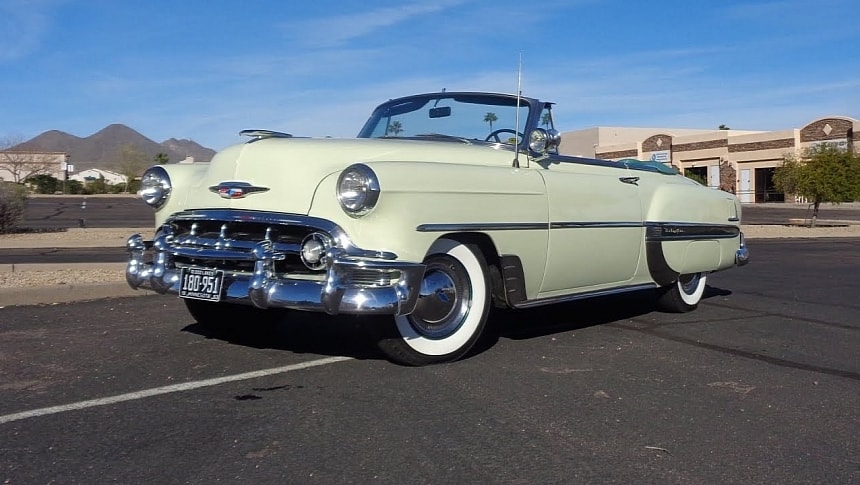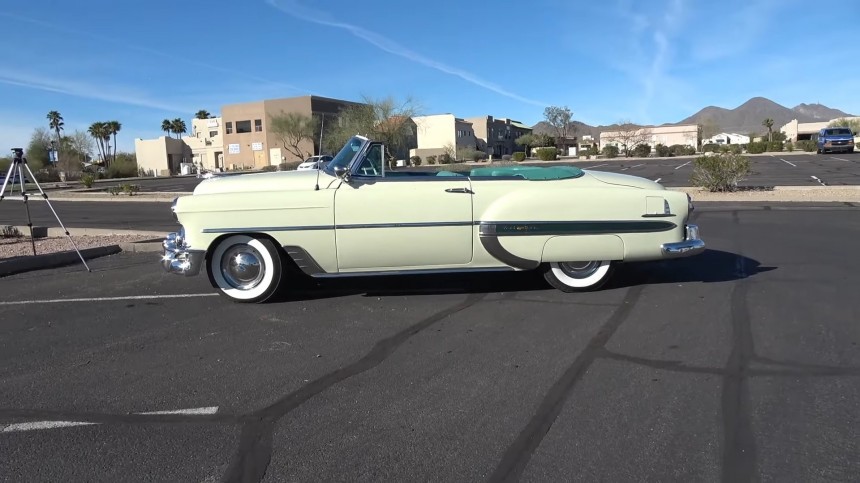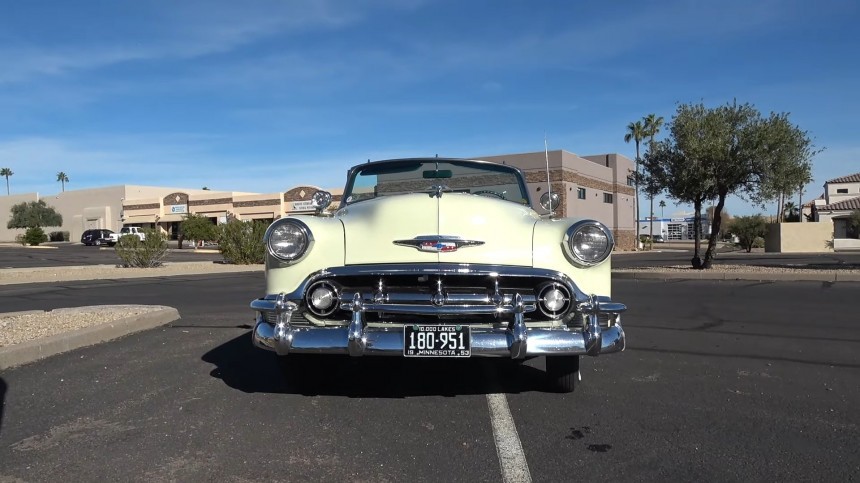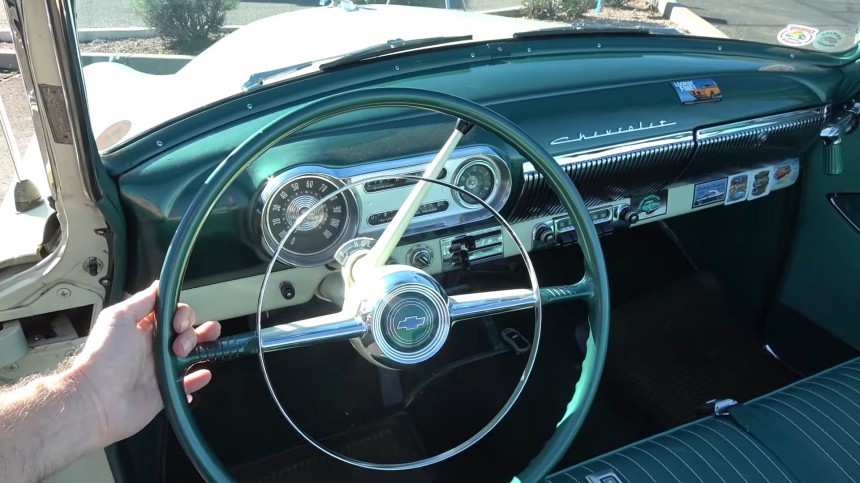1953 was a transition year for motoring America, and perhaps nothing represents it better than the Corvette. The new Chevrolet was not just an upheaval against sportscar imports from across the oceans but the signal of a revolution. The number-one-selling carmaker in America was done with the legacy of prewar fashion and the foggy second half of the forties, and it was sounding the trumpets of a new age in carmaking.
The Corvette’s launch in the dawning days of 1953 might have been a crucial moment for Chevrolet, General Motors, the American auto industry, and probably the entire world. Still, the fray was fought by all the models in the Bow Tie lineup. After all, with only 300 examples built, the Corvette was nothing more than a political statement. The heavy artillery fired the tried and tested nameplate shells that had made Chevrolet America’s piston sweetheart.
One of those names that propelled the entry GM division toward the future was the Bel Air. In 1953, the moniker was still teething and was promoted to series ranks. Unlike the 1950-1952 period, the Bel Air was now a four-model line topping the low-price offers on behalf of Chevrolet: two- and four-door sedans and a convertible joined the hardtop as the high-level choice for Chevy clientele.
The Bel Air name has been used since 1950 when a pillarless coupe fell amid Fleetlines and Stylelines—the two trim levels offered by the GM division. Its growing popularity prompted the manufacturer to expand the palette and capitalize on the nameplate’s momentum. With the new body styles, the Bel Air sold just under 514,000 units in 1953 – a quantum leap over the 254,000 sold in the previous three model years.
The 1953 Bel Air subseries doubled the choices for a convertible Chevrolet, coming alongside the 210 Deluxe two-door drop-top variant to meet the needs of those who preferred the open sky above their gearheadness. Again, the Corvette was more of a fashion icon than a serious offer that the buying public could consider.
Just over 24,000 Bel Airs left the factory with a cloth spread over a retractile rack, a number that would be considered high enough to rule out the ’53s from any club of rare automobiles. However, not nearly as many are around today, 71 years after their introduction, to dismiss them as ‘unworthy’ of our attention.
Look at the example in the video (and this is a first for the YouTuber, too): a 1953 Chevrolet Bel Air convertible - a rarity today and an outcast within the Bow Tie family, constantly living in the shadows of the fabled 1955-1957 generation (to Say nothing of the succeeding Impala that was born as a high-end Bel Air itself in 1958).
The stunning automobile belongs to Gary Krig, the affable gentleman smiling in front of Lou Costabile’s camera at the end of this past January in Arizona. He had owned the car since 2005, when he bought it from a buddy who had had it since 1970.
Ironically – or perhaps fatefully – Gary worked to restore this ’53 to factory condition and above factory specifications, adding whatever option would have been available to be ordered on the car at the time of its launch. The project was completed in the eighties - the then-owner of this extremely well-renovated Chevy turned to Mr. Krig first when the car was put up for sale. That’s how this particular Bel Air won first prize at beauty contests (for antique automobiles), and that also explains why it looks so fresh.
Granted, the owners took magnificent care of it, and the extremely good-looking ragtop is a masterpiece of American history. The inline-six engine – the best Go option available that year in any Chevrolet, sounds as healthy as the car looks. Never mind the corrosion spots under the hood – that’s the seal of authenticity for a classic that has almost 88,000 miles on the clock (141,500 km).
The Blue Flame straight six-cylinder motor is a 235.5-cube (3.86 liters) venerable motor that offered the hardest punch of any mass-produced Chevrolet in 1953. 115 hp and 200 lb-ft won’t impress a contemporary ‘smart’ coffee grinder. Still, it was the best Chevrolet powerplant available that year, short of Corvette’s (the sportscar had 160 hp to brag with, thanks to triple downdraft carbs).
The tw1o-speed automatic, the Powerglide, was proudly advertised on the trunk of the Bel Air, as it was exclusive to this model, and the 210 (Two-Ten, please), as an extra-cost option. Apart from this low-profile sign of superiority, the Bel Air had plenty of chrome spread over its curvy lines to tell it apart from the rest of the crowd.
Another notable feature introduced in 1953 was the one-piece windshield, a major technological breakthrough in glass-making. Unobstructed visibility was probably one of the major selling points for Bel Air, which secured a second-place sales position among the Chevrolet passenger cars of that year, not far behind the workhorse Two-Ten range. The Bel Air was Chevrolet’s secret weapon in beating Ford to the title of Carmaker of the Year (if only sales volumes are considered).
One of those names that propelled the entry GM division toward the future was the Bel Air. In 1953, the moniker was still teething and was promoted to series ranks. Unlike the 1950-1952 period, the Bel Air was now a four-model line topping the low-price offers on behalf of Chevrolet: two- and four-door sedans and a convertible joined the hardtop as the high-level choice for Chevy clientele.
The Bel Air name has been used since 1950 when a pillarless coupe fell amid Fleetlines and Stylelines—the two trim levels offered by the GM division. Its growing popularity prompted the manufacturer to expand the palette and capitalize on the nameplate’s momentum. With the new body styles, the Bel Air sold just under 514,000 units in 1953 – a quantum leap over the 254,000 sold in the previous three model years.
Just over 24,000 Bel Airs left the factory with a cloth spread over a retractile rack, a number that would be considered high enough to rule out the ’53s from any club of rare automobiles. However, not nearly as many are around today, 71 years after their introduction, to dismiss them as ‘unworthy’ of our attention.
Look at the example in the video (and this is a first for the YouTuber, too): a 1953 Chevrolet Bel Air convertible - a rarity today and an outcast within the Bow Tie family, constantly living in the shadows of the fabled 1955-1957 generation (to Say nothing of the succeeding Impala that was born as a high-end Bel Air itself in 1958).
Ironically – or perhaps fatefully – Gary worked to restore this ’53 to factory condition and above factory specifications, adding whatever option would have been available to be ordered on the car at the time of its launch. The project was completed in the eighties - the then-owner of this extremely well-renovated Chevy turned to Mr. Krig first when the car was put up for sale. That’s how this particular Bel Air won first prize at beauty contests (for antique automobiles), and that also explains why it looks so fresh.
Granted, the owners took magnificent care of it, and the extremely good-looking ragtop is a masterpiece of American history. The inline-six engine – the best Go option available that year in any Chevrolet, sounds as healthy as the car looks. Never mind the corrosion spots under the hood – that’s the seal of authenticity for a classic that has almost 88,000 miles on the clock (141,500 km).
The tw1o-speed automatic, the Powerglide, was proudly advertised on the trunk of the Bel Air, as it was exclusive to this model, and the 210 (Two-Ten, please), as an extra-cost option. Apart from this low-profile sign of superiority, the Bel Air had plenty of chrome spread over its curvy lines to tell it apart from the rest of the crowd.
Another notable feature introduced in 1953 was the one-piece windshield, a major technological breakthrough in glass-making. Unobstructed visibility was probably one of the major selling points for Bel Air, which secured a second-place sales position among the Chevrolet passenger cars of that year, not far behind the workhorse Two-Ten range. The Bel Air was Chevrolet’s secret weapon in beating Ford to the title of Carmaker of the Year (if only sales volumes are considered).





